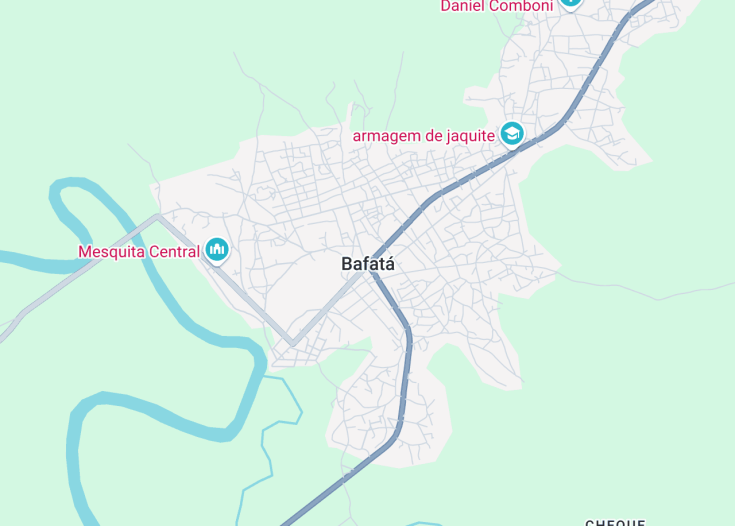Bafatá, a serene gem nestled in the heartlands of Guinea-Bissau, invites travelers to explore its rich cultural heritage and natural beauty. Once a pivotal site during the colonial era, today Bafatá is known for its bustling markets, tranquil river views, and friendly locals. The town serves as a living museum, showcasing traditional Portuguese architecture alongside indigenous influences, making it a fascinating destination for history buffs and cultural enthusiasts alike. Visitors are also drawn to the near-pristine natural surroundings, ideal for bird watching and leisurely river excursions.
Ensure to visit during the cooler months from November to February for a more comfortable exploration of Bafatá’s outdoor attractions.
Consider hiring a local guide to fully appreciate Bafatá’s historical sites and gain deeper insights into the town’s unique cultural tapestry.
Top things to do & see in Bafatá
Select the following sights and activities to discover best tickets and tours available in Bafatá.
Bafatá: The Heart of History and Culture in Guinea-Bissau
| Country | Guinea-Bissau |
| Time in Bafatá | GMT |
| Language spoken | Portuguese |
| Population | 225,530 (World Bank, 2021) |
| Currency | West African CFA franc (XOF ₣) |
| Airports |
|
Bafatá, a vibrant town in eastern Guinea-Bissau, serves as a rich cultural hub with a deep-rooted history. Once influenced by various colonial powers, Bafatá today is a testament to resilience and cultural amalgamation. It is known for its diverse community, where traditions and modernity blend seamlessly. Historical landmarks such as the local museum and colonial structures provide a glimpse into its storied past, while lively markets showcase the town’s vibrant daily life.
Where is Bafatá?
Located on the eastern part of Guinea-Bissau, Bafatálies gracefully along the Geba River, providing scenic views and a strategic location that has shaped its history.
Distances:
| Route | Distance by car | Time by car |
|---|---|---|
| Bissau to Bafatá | 120 mi | 3 hrs |
| Gabú to Bafatá | 35 mi | 1 hr |
| Bolama to Bafatá | 220 mi | 5.5 hrs |
What is Bafatá famous for?
Bafatá is renowned for its cultural heritage, particularly for its impact during the struggle for independence from colonial rule. It is also the birthplace of Amílcar Cabral, a prominent independence activist.
History
Pre-Colonial Period: Before the 19th Century
Originally inhabited by various ethnic groups, including the Mandinka, Bafatá’s pre-colonial history is marked by its position as part of the larger Mali Empire. The rich cultural and social heritage developed through interactions among diverse communities laid a foundation that has persisted through centuries. During this period, Bafatá was primarily a small agrarian society with trade in goods like salt, gold, and kola nuts enhancing economic activities.
Colonial Period: 19th Century – 1974
The transformation of Bafatá began with Portuguese colonization in the 19th century. As part of Portuguese Guinea, Bafatá was subjected to colonial exploitation primarily in the agricultural sector. During these years, European influences started penetrating local traditions and governance. The colonial period also saw Bafatá becoming a minor administrative post which significantly altered its societal structure.
Post-Independence Era: 1974 – Present
After Guinea-Bissau gained independence in 1974, Bafatá entered a new era of building a national identity and infrastructure. Despite political instability and economic challenges that have affected the country, Bafatá has been focusing on education and development projects to empower its population. The town is also proud of being the birthplace of Amílcar Cabral, a prominent independence activist, which is integral to its modern history and identity.
Visit Bafatá
What to see and do in Bafatá
Visitors to Bafatá can explore a rich cultural tapestry and historical landmarks. Key attractions include:
- The Amílcar Cabral Museum, dedicated to the life and contributions of Guinea-Bissau’s liberation leader.
- Exploring the vibrant local markets, where traditional crafts and fresh produce are sold.
- The colonial-era buildings that reflect the architectural styles brought by the Portuguese.
- Nearby natural reserves, ideal for bird watching and experiencing the region’s lush biodiversity.
Festivals and Events in Bafatá
Bafatá hosts several cultural and historical events throughout the year, celebrating its rich heritage and vibrant community spirit. Major events include the Independence Day celebrations on September 24th, featuring parades, music, and dance, highlighting the nation’s history and cultural diversity.
Best time to visit Bafatá
The best time to visit Bafatá is during the dry season from November to February when the weather is cooler and more comfortable for travel and outdoor activities.
Is Bafatá worth visiting?
Bafatá offers a unique glimpse into the history and culture of Guinea-Bissau. Its appealing aspects include historical sites like the Amílcar Cabral Museum and vibrant local markets. However, potential visitors should be aware of the limited tourist infrastructure and occasional political instability. Nevertheless, for those interested in African history and culture, Bafatá presents a compelling destination that can provide meaningful experiences and insights into the resilience and richness of Guinea-Bissau’s heritage.









